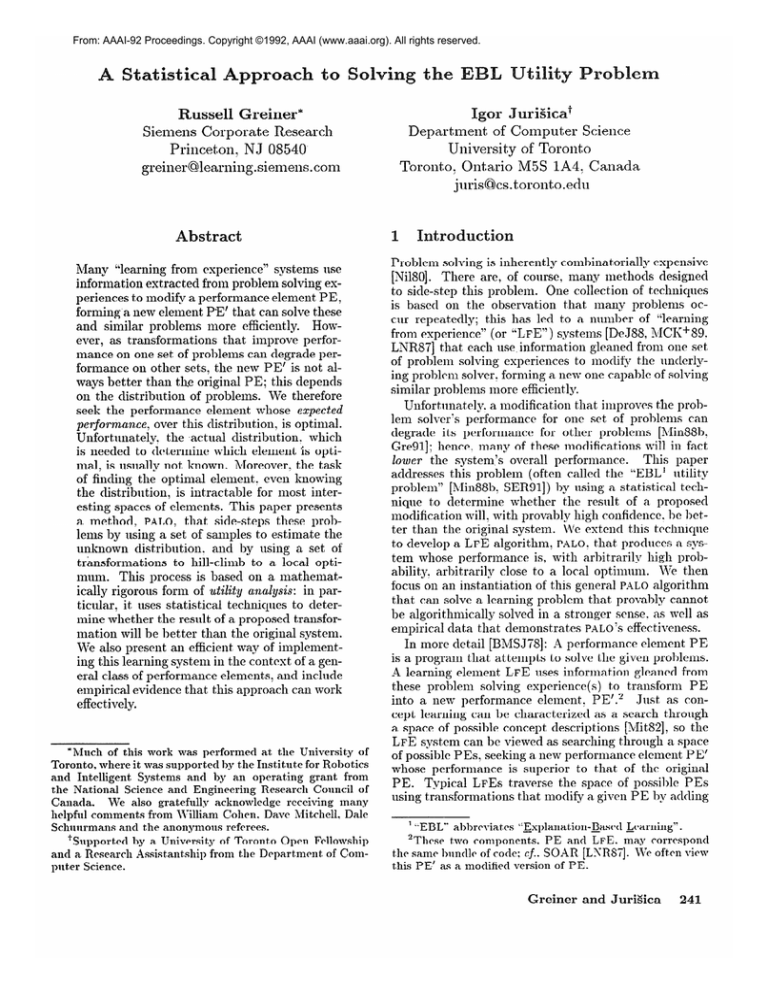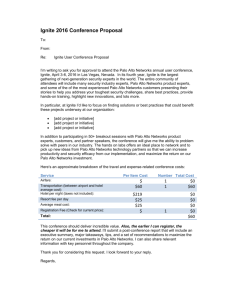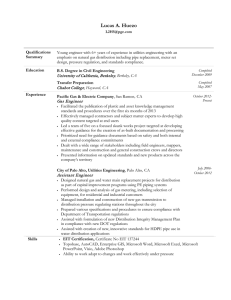
From: AAAI-92 Proceedings. Copyright ©1992, AAAI (www.aaai.org). All rights reserved.
Statistical
A
to Solving
Russell
Greiner*
Siemens Corporate Research
Princeton, NJ 08540
greiilep~leztrilii~g.sienleiis.com
Abstract
h4any “learning from experience” systems use
information estractecl from problem solving experiences to moclify a performance element PE,
forming a new element PE’ that can solve these
and similar problems more efficiently.
However, as transformations that improve performance on one set of problems can degrade performance on other sets, the new PE’ is not always better than tile original PE; this depends
on tlie clistribution of problems. We therefore
seek the performance element whose expected
perfornamce,
over this distribution, is optimal.
Unfortmiately.
the actual clistribntion. which
is needed to determine which element is optimal, is usually not known. h>Ioreover, the task
of finding the optimal element. cvcn knowing
tlie distribution, is intractable for most interesting spaces of elements. This paper presents
a method, PALO, tliat sicle-steps these problems by nsing a set of samples to estimate the
uiil;nown distribution. and by using a set of
tr&sformations
to Bill-climb to a local opti11111111.Tllis process is based on a mathematically rigorous form of utility unulgsis: in particular, it uses statistical tecliniqm33 to determine whether the result of a proposecl transformation will be better than the original system.
We also present an efficient way of implementing this learning system in the contest of a general class of performance elements, and include
empirical evidence that this approach can work
effectively.
*Much of this work was performed at the University of
Toronto, where it was supported by t,he Institute for Robotics
and Intelligent Systems and By an operating grant from
the National Science and Engineering Research Council of
Canada.
We also gratefully acknowledge receiving many
helpful comments from William Cohen. Dave Mitchell, Dale
Schuurmans and the anonymous referees.
‘Supported 1)~ a University of Toront.0 Open Fellowship
and a Research Assistantship from the Department of Computer Science.
t
ti
Igsr JuriSicd
Departiiieiit of Computer Science
University of Toronto
Toronto; Ontario M5S 1A4: Canada
juris@cs.toroi~to.edu
I
Introduction
Problem solving is inherently combinatorially expensive
[NilSO]. There are, of course, many methocls designed
to sicle-step this problem. One collection of techniques
is based on the observation that many problems occur repeatedly; this has led to a nmnber of “learning
from esperience” (or “LFE”) systems [DeJSS, hdCI<+SS.
LNR87] that each use,information gleaned from one set
of problem solving esperiences to modify the unclerlying problem solver. forming a new one capable of solving
similar problems more efficiently.
Unfortmiatcly. a modification that improves the problem solver’s performance for 011~ set of problems can
clegracle its performance for other problems [hiinS$b,
GreSl]; hence. many of these modifications will in fact
lower the system’s overall performance.
This paper
aclclresses this problem (often called the “EBL’ utility
problem” [h%lSSb, SERSl]) 1)y using a statistical technique to cletermine whether the result of a proposed
modification will, with provably high confidence, be bcfter than the original system. We cstcncl this tcclinique
to develop a LFE algorithm, PALO. that produces a system whose performance is, with arbitrarily big11 probability. arbitrarily close to a local optimum.
We then
focus on an instantiation of this general PALO algorithm
that can solve a learning problem that provably camlot
be algorithmically solved in a stronger sense. as well as
empirical clata that demonstrates PALO’s effectiveness.
In more cletail [Bh!ISJ%]: ,4 performance element PE
is a program that attempts to solve the given problems.
A learning element LFE uses information gleaned from
these problem solving esperience(s)
to transform PE
into a new performance element: PE’.’
Just as coilcept learning can be characterized as a search through
a space of possible concept descriptions [kIit$2], so the
LFE system can be viewed as searching throng11 a space
of possible PEs, seeking a new performance element PE’
whose performance is superior to that of the original
PE. Typical LFES traverse the space of possible PEs
using transformations tllat modify a given PE by adding
’**EBL” ablxcviat,cs “&planation-IJasd
hcarning” .
“These t,wo components. PE and LFE. may correspond
the same hundlc of code: cf.. SOAR [LNRS’T]. We often view
this PE’ as a modified version of PE.
Greiner
and Jur%ica
241
macro-rules, re-ordering the rules, adding censors to existing rules, and so on.
Our previous papers have presented algorithms that
find the PE’ whose performance
is optimal [GL89,
GreSl] or nearly-optimal
[OG90, G091]? where performance is measured as the expected cost of a PE over
some fixed distribution of problems. Unfortunately, the
task of finding the globally optimal PE is intractable for
most interesting cases [GreSl].
In contrast F most other previous
LFE
research
[DeJ88, MCIi+89,
LNR87] has focused on experimental techniques for incrementally modifying a problem
solver, producing
a series of performance
elements
PEo, . . . , PE,
where each PE i+i is a modification of
PEi (e.g., PEi+i might contain one new macro-rule not
in PE;). Unfortunately, esisting methods do not always
guarantee that each PE i+l is an improvement
over PEi;
a fortiori, the overall m-step process may produce a final
PE,
that is not even superior to the initial PEe, much
less one that is optimum in the space of PEs.~
This paper integrates ideas from both lines of research,
by describing a tractable incremental
algorithm that is
(probabilistically)
g uaranteed to find a locally optimal
performance element. Iii particular, Section 2 motivates
the use of “expected cost” as a quality metric for performance elements. Section 3 then clescribes a statistical tool for evaluating whether the result of a proposed
modification is better (with respect to this metric) than
the original PE; this tool can be viewed as mathematically rigorous version of [MiiQBa] ‘s “utility analysis” .
It uses this tool to define the general PALO algorithm,
that incrementally produces a series of performance elements PEo, . . . , PE,
such that each PEi+i is statistically likely to be an incremental improvement over PEi
and, with high confidence, the performance of the final
element PE,
is essentially a local optimal. Finally, Section 4 presents an instantiation of this program that uses
a specific set of transformations to “hill-climb” in a particular, very general, space of performance elements. It
also presents an efficient way of obtaining approsimations to the information PALO needs? and provides empirical evidence that this program does work effectively.
Here, PALO is efficiently finding a locally optimal PEl,
in a space of PEs for which the globally optimal PE,,
cannot be tractably found. The conclusion discusses how
this work extends related research.
2
Framework
We view each performance element PE as a function that
takes as input a problem (or query or goal, etc.) to solve,
q, and returns an answer. In general, we can consider
a large set of (implicitly defined) possible performance
elements, (PEi};
Section 4 considers the naturally occurring set of problem solvers that use different control
strategies.
Which of these elements should we use; i.e., which is
“best”? The answer is obvious: The best PE is the one
that performs best in practice. To quantify this, we need
3Section 5 provides a more comprehcnsiye literature
search, and includes a few exceptions to the above claims.
242
Learning: Utility and Bias
to define some measure on these elements: We start by
defining c(PEj, 4;) to be the “cost” required for PEj
to solve the problem qi. (The c(., .) function defined in
Section 4 measures the time required to find a solution.)
This cost function specifies which PEj is best for a single problem. Our PEjs, however, will have to solve an
entire ensemble of problems & = { 4; }; we clearly prefer
the element that is best overall. We therefore consider
the distribution of queries that our performance element
will encounter, which is modelled by a probability function, Pr : & I+ [0, 11, where Pr[ qi ] denotes the probability that the problem qi is selected. This Pr[ -1 reflects
the distribution of problems our PE is actually acldressing; n. b., it is not likely to be a uniform distribution
over all possible problems [Go179], nor will it necessarily
correspond to any particular collection of “benchmark
challenge problems” [Ke187].
We can then define the expected cost of a performance
element :
C[ PE]
‘ef
E[c(PE,
q)]
=
c
Pr[cl]
x c(PE,
cd
qEQ
Our mlderlying challenge is to find the performance
element whose expected cost is minimal.
There are!
however, two problems with this approach: First, we
know to know the distribution of queries to determine
the expected cost of any element and hence which clement is optimal; unfortunately the distribution is usually
not known. Second, even if we knew that distribution
information, the task of identifying the optimal element
is often intractable.
3
The
PALO
&prithm
This section presents a learning system, PALO, that
side-steps the above problems by using a set of sample
queries to estimate the distribution, and by efficiently
hill-climbing from a given initial PEo to one that is, with
high probability, close to a local optimm11. This section
first states the theorem that specifies PALO’s fimctionality, then summarizes PALO’s code and sketches a proof
of the theorem.
PALO takes as arguments an initial PEa and parameters e, 6 > 0. It uses a set of sample queries clrawn
at random from the Pr[ .] distribution4 to climb from
the initial PEe to a final PE,,
using a particular set of
possible transformations T = { rj } , where each Tj maps
one given performance element into another; see Subsection 4.2. PALO then returns this final PE,,. Theorem 1
states our main theoretical results.5
Theorem
1 The PALO( PEo, E, 6) process
increnaentally produces
a series
of performance
elements
PEo, PE1,. . . , PE,,
staying at a particular
PEj for
only a podynomial number of samples before either clinabing to PEj+i
or terminating.
With probubility at Zeast
1 - 6, PALO will terminate.
It then returns un element
*These samples may be produced by the user, who is simply asking questions relevant to one of his tasks.
5Tllis proof, and others, appear in the espanded version
of this paper [GJ92].
Algorithm
PALO(
e ico
PEo, E, 6 )
c(PEp,
Ll: Let S + {}
A maz =
L2:
where A is the range of possible values of c(PE,,
jto
max { h[PE’,
PEj]
] PE’ E Neigh }
(from the user).
Let
su
s
+
i t
{a)
i + INeigh]
e If there is some PE’ E Neigh such that
A[PE’,
PEj,S]
2
(1)
R[PE’, PEj] Jm
then let
PEj+r
Return to
Ll.
e If
ISI >
+
2A$ae In
VPE’ E Neigh.
PE’,
$$
(
>
A[PE’,
and
S]
<
(2)
9
then halt and return as output PEjo Otherwise, return to L2.
Figure 1: Code for PALO
PE,
whose expected utility c[ PE,,
at least 1 - S, both
1. at least’ as good as the
C[PE,]
5 q PEo];
and
] is, with probability
orh$nal
2. an E-local optimum’ - i.e.,
V7-j E 1. qPEm]
5
c[. Tj(PEm.)
] +
PEe;
i.e.,
Cl.
E
The basic code for PALO appears in Figure 1. In
essence, PALO will climb from PEj to a new PEj+i
if
is likely to be strictly better than PEj; i.e., if
PEj+l
we are highly confident that C[ PEj+i ] < C[ PEj 1. TO
determine this, define
cli = A[PE,, PEp,qi] dLf c(PE,, qi) - c(PEp, qi)
to be the difference in cost between using PE, to deal
with the problem qi, and using PEP. AS each query qi is
selected randomly according to a fixed distribution, these
dis are independent, identically distributed random variables whose common mean is ,X = C[ PE, ] - C[ PEP 1.
(Notice PEP is better than PE, if 1-1> 0.)
Let
Y,
‘zf
iA[PE,,
PEP,
{q;)F=i
] be
PEp]
gi) -
is also Lzsed in both
we should be that C[ PE’] > C[ PEj ] (Equation 1) and
whether any “7-neighbor” of PEj (i.e., any rk(PEj)
) is
more than E better than PEj (Equation 2).
4
j + j + 1.
PEj,
This A = A[PE,,
the specification of A,,,
and in Equation 1. Section 4.2
below discusses how to compute this value for relevant
PE;/rj (PEi) pairs.
The PALO algorithm uses these equations and the values of A[ PE’, PEj, S] to determine both how confident
Neigh C- { rk(PEj)}k
Get query q
qi).7
the
sam-
ple mean over n samples, where A[PEa,
PEB, S] def
Cq&wL
4) - c(PEp, 4) for any set of queries S.
This average tends to the population mean, p as n -+ 00;
i.e., p = lim,,,
Y,z. Chernoff bounds [Che52] describe
the probable rate of convergence: the probability that
“I<, is more than p + y” goes to 0 exponentially fast as n
increases; and, for a fixed n, exponentially as y increases.
Formally,
‘Notice a “O-local optimal” corresponds to the stanclard
notion of “local optimal”; hence “e-local optimal” generalizes
local optimality.
Instantiation:
Strategies
Learning
Go0
The algorithm shown above can deal with essentially arbitrary sets of performance elements, cost functions and
This section presents a parsets of transformations.
ticular instantiation of this framework: Subsection 4.1
presents a moclel for a general class of “graph-based performance elements” ‘PEG and the obvious cost function.
Subsection 4.2 then describes the set of “re-ordering”
transformations IRo, each of which re-arranges the order in which PE traverses the arcs of the graph. It also
describes an efficient way of approsimating
the values
of A[rj(PE),
PE, S]. S ub section 4.3 presents some empirical results that demonstrate that a system that uses
these approximations can be effective.
We choose the PEG class of performance elements as it
corresponds to many standard problem solvers (including PROLOG
[CiVfSl]; see also [GNU]);
and the IRo
class of transformations on strategies, as it corresponds
to many EBL systems and moreover, the task of finding
the global optimality strategy is NP-hard [GreSl].
4.1
Graph Based PEs
This subsection uses a particularly simple performance
element PEo to illustrate the class PEG, whose elements
each correspond to a finite graph whose arcs have fixed
costs.
After describing a relatively simple model. it
presents several extensions, leading to a more realistic,
comprehensive model.
The PEe element is based on the rules shown in the
upper left corner of Figure 2 (producing the corresponding “reduction graph” shown in that figure), operating
with respect to the facts shown in the lower left corner.
We focus on how this system deals with queries of the
form GoodCar
, for some ground K - e.g., returning
Yes to the queries GoodCar(D1)
and GoodCar(D2))
and
No to the queries GoodCar(D4)
and GoodCar(Fido)
.
In general, we can identify each performance element
PE = (6, 0) E PEG with a reduction graph G and a
strategy 0, where a reduction graph G = (N, A. S, f) is
a structure formed by a set of rules: 1’v is a set of nodes
(each corresponding to a proposition; e.g., the nocle iVe
corresponds to “GoodCar( K> ” and ~1’2corresponds to the
empty disjunction), and A c N x N is a set of arcs, each
corresponding either to the use of a rule (e.g., the al arc
‘See [Bol85, p. 121. N.b., these inequalities holds for cssentially urbitrury distributions,
not just normal distributions,
subject, only to the minor constraint that the sequence {A;}
has a finite second moment.
Greiner and Juri%ca
243
a~:
-
Fact Set
Cheap(D2),
Cheap(D3) , Cheap(D51,
Red(Di),
Red(D3),
Red(DEi), . . .
Gold(DG),
...
(Attempt:
Cheap(n)
pt:
...
Figure 2: “Reduction
Graph” GA (used by PEQ and PEr)
from No to Nr is based on the rule RI) or a database
retrieval (e.g., the u2 arc from Nr to N2 corresponds
to the attempted database retrieval Cheap(K)).
The set
S c N is the subset of N’s “success nodes” (here, each is
an empty disjunction such as N2 or N5, shown in doubled
hoses); reaching any of these nodes means the proof is
successful. The cost function f : A H 7Z$ maps each
arc to a non-negative value that is the cost required to
perform this reduction. We will let fi refer to the value
of f(@
The strategy 0 specifies how the PE will traverses its
graph G. Here, it corresponds to a simple sequence of
arcs, e.g.,
@(my)
=
(al, a2,
a3,
a4,
a5,
a6, a7)
(3)
is the obvious left-to-right depth-first strategy, with the
understanding that PE = (GA, Otcrg)) stops whenever
it reaches a success node (e.g., if a2 succeeds, then PEe
reaches N2 and so stops with success), or has exhausted
all of its reductions.’ There are other possible strategies,
including other non-left-to-right
depth-first strategies,
e.g.,
q?-9,)
=
(a3,
a4,
a5,
a3, a7, al,
(G.4,
Q-,))
and
P&
=
(GA,
(4)
a2)
as well as non-depth-first strategies, etc.
We focus on two members of P4?G:
PEe
=
@(,,,)).
Cost of Solving Problems: We can compute the cost
for PEj to solve qi, c( PEj, gi), from the above specification. For example, c(PEa, GoodCar(D2) ) = fi + f2,
ad @Eo,
GoodCar(
= fl + f2 + f3 + f-4 + f5, as
the (al, up) path failed as Cheap(D1) is not in the fact
set. As each strategy stops as soon as it finds an answer,
clifferent strategies can different costs for a given query;
e.g., c(PE1, GoodCar(D1))
= fa + f4 + f5 differs from
c( PEe , GoodCar (Dl) ), etc.
We can view each strategy as a sequence of paths,
where each path is a sequence of arcs that descend
‘Notice
that strategies, in&ding
PEo, accept the first
solution found, meaning they are performing “satisficing
searches” [SK75].Hence, we are only considering the cost required to produce an answer, and not the quality of the answcr itself. There are obvious extensions to this cost model
that can incorporate different utility values for answers of
different8 “qualities”; see [GE91].
244
Learning: Utility and Bias
Gold(K))
from some already-visited node down to a retrieval; e.g.,
We define the e201
=
( (a1 a2),
( a3 a4 as), (~6 a~) ).
petted cost of a strategy as the weighted sum of the costs
of its paths, each weighted by the probability that we
will need to pursue this path, i.e., that none of the prior
paths succeeded [Smi89, G091]. (Of course, the cost of
a path is the sum of the cost of its arcs.)
While the models of performance elements and cost
presented above are sufficient for the rest of this article,
they appear quite limited. We close this subsection by
presenting some of the extensions that lead to a more
comprehensive framework. N. b., the model presented in
[GJ92] incorporates all of these extensions.
Extendl.
(G eneral Graph) The above definitions are
sufficient for the class of simple “disjunctive reduction
graphs”, which consist only of rules whose antecedents
each include a single literal. To deal with more general rules: whose antecedents are conjunctions of more
than one literal (e.g., “B(X)&!(X)
+ A(s)“)? we must
use directed hyper-graphs: where each “hyper-arc” clescends from one node to a set of children nodes: where
the conjunction of these nodes logically imply their
common parent. We would also define S to be a set of
subsets of N, where the query processor woulcl have
to reach each member of some s E S for the derivation to succeed. This extension leads to additional
complications in specifying strategies; see also [G091,
Appendis A].
Extend2.
(Probabilistic Experiments) We say that “the
arc ai is blocked in the context of the query q” if no
strategy can traverse a; when answering the query q;
e.g., the retrieval arc a2 is blocked in the contest of
GoodCar(D1)
as the associated literal Cheap(D1) is
not in the fact set. So far, we have implicitly assumecl that retrieval arcs can be blocked, but rulebased arcs cannot. If we permit the literals in the rules
to include constants, however, rule-based arcs can also
be blockable. Consider, for esample, adding the rule
“VX Owner(Fcar, s) + GoodCar(Fcar)“,
which states
that the particular car Fear is goocl if it is owned by
anybody. Notice a performance element will be able to
traverse the rule-based reduction arc from GoodCar (z)
to Owner(Fcar, LC)only if the query is GoodCar(Fcar);
notice this arc is blocked for every other query. Our
model can handle these situations by allowing any arc
(not just retrieval arcs) to be blockable.
Extend3.
(General Cost Function) The algorithms presented in this paper can accommodate more complicated f(e) cost functions, which can allow the cost of
traversing an arc to depend on other factors - e.g.,
the success or failure of that traversal, which other
arcs have already been traversed, etc.
Extend4
(Infinite Set of Queries) Our analysis can accommodate even an infinite number of queries, as we
can partition them into a finite set of equivalence
classes, where all members of an equivalence classes
have the same cost for each strategy.
This follows
from the observation that the cost of using a strategy to solve a query depends only on which arcs are
blocked, meaning we can identify each query with the
subset of arcs that can are blocked for that query. For
example, we can identify the query GoodCar(B1) with
the arc-set (~2, a~} and GoodCar(B2)
with {as, a7},
etc.
4.2
Re-Ordering
Transformations
This subsection considers a way of modifying a performance element PE = (G, 0) by reordering the strategy (i.e., changing from 0 to 0’) while preserving the
underlying reduction graph G. For example, after-finding that (ai, a2) failed but the (u3, ~4, -us) path succeeded, one might transform PEe = (GA, et,,,))
into
moving
a3
(and
its
children)
bePE1 = (GA, +-gc)),
by
fore al. (and its children). In general, given any reduction
graph G = (N, A, S, f), define IRo = {~~1,~2}~1,~2 to be
the set of all possible “simple strategy transformations”,
as follows: Let rl, r2 E A be two arcs that each descend
from a single node (e.g., al and a3 each descend from
the node No); and consider any strategy
@A =
z-1 0 7l-2 0 7i-3 0 x4,
(5)
where the o operator is concatenation and each nj is
a (possibly empty) sequence of arcs, and in particular, ~2 = (rl, . . .) corresponds to rl and its children,
Then
and 7r3 = (~2, . . .), to r2 and its children.g
og = rTl,r2 (@A) will be a strategy that differs from
Oe only in that rl and all of its descendents are moved
earlier in the strategy, to before r2; i.e.,
@B
=
7rl,r2(@A)
=
7r1 0 -2
z-3 0 7r9 0 x4 .
(6)
(To understand the transformation
from @A = et,,,)
@B
x2
=
%3,,,
&rg))
=
@(rgc):
let
=
(%,a2),
to
‘IT3 =
(as, a4, u5, ~6, a~) and ~1 = ~4 = 0.) Notice that the
rrr,r2 transformation will map a strategy 0 to itself if rl
already comes before r2 in 0. TRo is the set of all such
This can
S, recording the total cost each requires.
be expensive, especially when there are many differFortunately,
there is an alternative
ent rj (PEi)s.
that involves running only the PEi element and using the statistics obtained to find both under-estimates
L(PE;,
rj(PEi),
S) 5 A[PE;,
rj(PE;),
S] and overestimates U(PEi, rj(PEi),
S) 2 A[PEi,
rj(PEi),
S],
that can be used in Equations 1 and 2, respectively.
In general, the PEA = (G, @A) element terminates as
soon as it finds an answer; based on the decomposition
shown in Equation 5, there are four cases to consider, depending on the path (one of { ~1,7r2,7r3,7r4}) in which this
first answer appears. (For our purposes here, we view
“finding no answer at all” as “finding the first answer in
the final 7r4”.) If this first answer appears in either or ~1
or ~4, then A[PEA, PEB,~] = 0, where PEB = (G, 0~)
from Equation 6. If the first answer appears in ~3, then
we know that A[PEA, PEB,~] = f(rz),
where f(ri)
in
general is the sum of the costs of the arcs in 7ri. For example, consider using PEe to deal with the Goodcar (Di)
query: As the a2 arc fails and a5 succeeds, the first answer appears within 7r3 = (as, ~4, u5,a6, a7). PEo will
find that answer, after it has first examined the path
7i2 = (al, a2) at a .cost of f(r2)
= f( (al, a2)) = f-1 + f2.
Notice PEr would also find this same solution in ~3.
However, PEi would not have first examined ~2, meaning its cost is f(7r2) kess than the cost .of PEo. Hence,
A(PEo,PEr,GoodCar(Dl))
= f(n2).
The situation is more complicated
if the first answer appears in 74, as the value of A[PEA, PEB. Q] depends on information that we cannot observe by watch(E.g., consider using PEo to deal
ing PEA alone.
with Goodcar(D2).
As a2 succeeds, PEo’s first answer
appears in 7r2. As PEe then terminates, we do not
know whether an answer would have appeared within
ns.)
While we cannot determine the exact value of
A[PEA,
PEB,
41 in these situations, we can obtain upper and lower bounds, based on whether a solution would
have appeared in those unexplored paths: here -f( 7r3) 5
A[PEA, PEB, 41 5 f(7r2) - f+(n3), where f+(ns)
is defined to be the cost of finding the first possible solution in
the path 7rs. (E.g., f+(( a3~~4~a5~a6~a7))
=f3+f4+.f5,
as this is the first solution that could be found. Notice
this under-estimates the cost of this path in every situation, and is the actual cost if the retrieval associated
with a5 succeeds.)
The table below gives the lower and upper bounds
L(q) 5 A[PEA, PEB, q] 5 U(q), for all four cases (one
for each 7ri):lO
Trl ,r2S-
Approximating A[PEi, PE’, S]: The PALO algorithm
requires values of A[PE,: , rj (PEi), S] for each 7-j E
1.
One obvious (though espensive) way of obtaining these values is to construct each rj(PEi)
performance element, and run this element on each q E
This table only bounds the value of A[ PEA, PEB, q]
The value of A[ PEA, PEB, S]
for a single sample.
‘To simplify the presentation, this article will only consider depth-first strategies; [GJ92] extends this to deal with
arbitrary strategies.
“[G.J92] shows how to obt,ain slightly tighter bounds,
based on information that is available from PE,4’s
computation.
will be between
L(PEA,
PEB,S)
def CclcsL(q)
Greiner and JuriGca
and
245
U(PEA,
PEB,
S)
‘ef
C4eS U(q).
To compute
these
bounds, we need only ma&ain
a small number of counters, to record the number of times a solution is found
within each subpath: let kz (resp., ks) be the number
of times the first solution appears within r2 (resp., x3);
then
L(PEA,PEB,S) =
U(PEA,PEB,S) =
h *[f(r2>I - k2 *[-f(~3)I
k3 . [f(77.2)]
k2 . [f(nz)
+
-
f(r3>1
PALO’ Process:
Now define PALO’ to be the variant of
PALO that differs only by using these L(PE’,
PEj, S)
values (resp . , U(PE’,
PEj, S) values) in place of
A[PE’,
PEj, S] in Equation
1 (resp., Equation 2).
upper and lower bounds of
PALO’ can compute
A[PE, 7j(PE), S] for each ~~1,~2 E IRo
using only the
values of a small number of counters: in general, it needs
to maintain only one counter per retrieval.
To complete our description:
PALO’ also needs one
more counter to record the total number of sample
queries seen, corresponding to 15’1. Equation 1 needs
the (static) values of A[7,r,r2(PE~),
PEA)] for each rk E
IRo.
Each ~~1.~2induces a particular segmentation of
each strategy into the subsequences @A -= n-1 0 7r2 0
7r3 0 x4.
Here,
+~,Y~(PEA),
as each value of A[ v-,~,~~(PEA),
t-f(r3)7
4.3
PEA]
=
PEA,
f(r2)
+
f(n),
41 is in the range
f(r2)l.
Empirical Results
The PALO algorithm only works “statistically”,
in that
its results are guaranteed only if the samples it sees are
truly representative of the distribution, and moreover, if
the distribution from which these samples is drawn is stationary. The PALO’ algorithm is even more problematic,
as it only uses approximations of the needed statistics.
Given these hedges, it is not obvious that the PALO’
algorithm should realZy work in a real domain. We are
beginning to experiment with it in various real domains,
including expert systems and natural language processors.
Here, we report on its performance in various artificial
settings, where we can insure that the distribution is
stationary. l1 Consider again the reduction graph shown
in Figure 2, and’assume unit cost for’each arc, whether it
represents a rule-based reduction or a database retrieval.
We will define the distribution of queries in terms of
the (independent) probabilities of the various database
retrievals; here,
P( Cheap(%)
P( Red(K)
P( Gold(&)
in Fact Set } GoodCar
in Fact Set 1 GoodCar
in Fact Set 1 GoodCar
query asked)
query asked )
query asked)
=
=
=
0.01
0.2
0.8
Given these values, it is easy to compute the expected
costs of the various strategies [Smi89]: C[ O(,,,) ] =
= 2.96 and
3.772, C[ @(,,) ] = 3.178, C[ @(,,,)I
CL@(,t-c)
1 = 2.36; hence, the optimal strategy is
l1 We decided against using a blocks-world example as it
would be more complicated to describe, but would be no more
meaningful as we would still have to make up a distribution
of problems, specifying how often a problem involves stacking
blocks,, versus forming arches, versus . . .
246
Learning: Utility and Bias
q,,,). l2 Of course, we do not initially know these probability values, and so do not know which strategy is optimal.
We ran a set of experiments to determine whether
PALO’, starting with Olcrg), would be able to find a good
strategy. We set S = 0.05 (i.e., a 95% confidence bound),
and considered E E (1.0, 0.5, 0.2, 0.1, 0.05 ), trying 10
trials for each value.
Using E = 1.0, PALO’ quickly found the strategy et,,,),
which is a l.O-local optimum (even though it is not the
global optimum).
As et,,,)
is “7”“-adjacent”
to the
initial O(,,,), this meant PALO’ performed only one hillclimbing step. PALO’ used an average of ]Sl fi: 5.3 sample queries to justify climbing to et,,,),
and another on
average = 44 queries to realize this strategy was good
enough; hence, this total learning process required on
average M 49 total queries. For the smaller values of
E, PALO’ always went from @(,,,)
to @(,,,) as before,
but then used a second hill-climbing step, to reach the
globally-optimal O(,,,). As would be expected, the number of steps required for each transition were about the
same for all values of E (notice that Equation 1 does
not involve E) : for E = 0.5, 0.2, 0.1, 0.05, PALO’ required about 6.3, 6.6, 5.0, 5.4 samples to reach et,,,),
and then an additional 31.5, 36.6, 39.0, 29.8 samples to
reach a(,,,).
The major expense was in deciding that this et,,,)
was in fact an e-local optimum;
here, this required
an additional
204, 1275, 5101, 20427 samples, respectively.
Notice
this is not time wasted:
the
overall “0 ~g,,~-performance-element-&-PALO’-learningelement” system is still solving relevant, user-supplied,
and doing so at a cost that is only
problems,
slightly more expensive than simply running the O(,,,)performance-element
alone, which we now know is an
optimal element. In fact, if we ignore the Equation 2
part of PALO’s code, we have, in effect, an anytime algotithm [BD88, DB88], that simply returns better and
better elements over time.
Of course, there are advantages to knowing when we
have reached a local optimum: First, we can then switch
off the learning part and thereafter simply run this (probably locally) optimal performance element. Second, if
we are not happy with the performance of that element,
a PALO-variant can then jump to different performance
element in another part of the space, ‘and begin hillclimbing from there, possibly using a form of simulated
annealing approach [RMt86].
The extended paper [GJ92] presents other experimental data, based on other probability distributions, reduction graphs, parameter values, and so forth. In general,
PALO”s performance is similar to the above description:
For each setting, PALO’ climbs appropriately, requiring
successively more samples for each step. Our one surprise was in how conservative our approximations were:
using the S = 0.05 setting, we had anticipated that PALO’
would miss (i.e., not reach an e-local optimal) approx12We continue to identify each strategy with the sequence
of database retrievals that it will attempt. Hence, Ot,,.,) =
(a5,a6:a7,a3,a4,al,a2).
imately 1 time in 20. However, after several hundred
runs, with various settings and graphs, we have found
that PALO”s error rate is considerably under this rate.
We are now experimenting with variants of PALO’ that
are less conservative in their estimates, in the hope that
they will be correspondingly less sample-hungry.
(See
also [GD92] .)
Finally, while this paper has focused on but a single
set of proposed transformations IRo,
there are many
other transformation sets TX that can also be used to
find an efficient satisficing system; e.g., [Gre92a] discusses a set of transformations that correspond to operator compositions. l3 The “PALO-style” approach is not restricted to speed-up learning; it can also be used to build
learning systems that can find performance elements
that are nearly optimal in terms of other measures, including accuracy [Gre92d] or categoricity [Gre92b]; see
also [GE91, Gre92c].
5
Conclusion
Comparison with other relevant research: There
are many other research projects - both theoretical and
empirical - that also address the task of using a set of
examples to produce a more efficient performance element. Most of the formal models, however, either deal
with learning problems that are far harder than the problems actually attempted by real learning systems (e.g.,
[GL89, GregI]) or model only relatively narrow classes of
learning algorithms (e.g., [NT88, CohSO]). By contrast,
our model is very general and directly relevant to many
systems.
There are also a great number of existing LFE systems, and considerable experimental work on the utility
problem. Our research is not simply a retrospective analysis of these systems; it also augments that experimental
work in the following specific ways. First, we show analytically that one subproblem of the utility problem the problem of determining if a proposed modification
is in fact an improvement - can be (probabilistically)
solved a priori (i.e., before building.that proposed modified system), based on only a polynomial number of test
cases. This result analytically confirms previous experimental results. Second, we show that utility analysis can
be used to probabilistically guide an incremental learner
to a performance element that is essentially a locally
optimal PE. (While existing systems have used utility
analysis when climbing to elements with superior performance, none have used it to produce elements that are
guaranteed to be optimal, in even our weak sense.) Finally, we can use our utility analysis to determine when
not to learn - i.e., to determine when none of the possible transformations is (likely to be) an improvement.
While this aspect of utility analysis has not yet been
13This requires a slight variant of the basic PALO algorithm
shown in Figure 1: That algorithm assumes that there is a
fixed set of neighbors to a given performance element. By
contrast, the number of possible macros depends on the number of .rules in the system, which grows as more rules are
added. This involves certain changes to the PALO algorithm;
see [CG91].
investigated empirically, it is likely to be important in
practice, as it can prevent a learning algorithm from
modifying, and therefore possibly degrading, an initial
element that happens to already be optimal. The correct action for the learner to take for such initial PEs is
simply to leave them unmodified - i.e., not to learn.
The work reported in [GD91, GD92] is perhaps the
most similar to ours, in that their system also uses a
statistical technique to guarantee that the learned control strategy will be an improvement, based on a utility
analysis. Our work differs, as we formally prove specific
bounds on the sample complexity, and provide a learning system whose resulting PE’ is (with high probability)
both superior to the initial PE and a local optimal.
Contributions:
Learning from experience (LFE) research is motivated by the assumption that problems
are likely to reoccur, meaning it may be worth transforming an initial performance element into a new one
that performs well on these problems.
Most existing
LFE systems actually perform a series of such transformations; in essence searching through a space of possible
PEs, seeking an efficient performance element PE’. This
underlying efficiency measure depends on the overall clistribution, which unfortunately is typically unknown. We
therefore define an algorithm PALO that can use samples
to reliably navigate through this space of possible performance elements, to reach a PE’ that is essentially a
local optimal. These transformations require certain statistical information; we also describe how to obtain such
information efficiently -- at a cost that is only minimally
more expensive than running a single performance element. Finally, we present a specific application of this
algorithm for a particular relevant space of PEs, one for
which the task of finding a globally optimal PE is NPcomplete, and include empirical data that confirms that
the PALO system can work efiectively.
References
[BD88]
M. Boddy and T. Dean. Solving time dependent planning problems.
Technical report,
Brown University, 1988.
[BMS 5781 13. Buchanan, T. Mitchell, R. Smith, and
C. Johnson, Jr. Models of learning systems.
In Encyclopedia
of Computer
Science
and
Technology, volume 11. Dekker, 1978.
Random
Graphs.
[Bo185]
B. Bollobas.
Press, 1985.
[CG91]
W. Cohen and R. Grciner. Probabilistic hill
climbing. In Proceedings of CLNL-91. Berkeley, September 1991.
[Che52]
H. Chernoff. A measure of asymptotic efficiency for tests of a hypothesis based on the
sums of observations. Annals of Matkematl:cal Statistics, 23:493-507,
1952.
[CM811
W. Clocksin and C. Mellish. Programming
in Prolog. Springer-Verlag, New York, 1981.
[CohSO]
W. Cohen. Using distribution-free learning
theory to analyze chunking. In Proceeding of
CSCSI-90,
1990.
Greiner
Academic
and JuriGca
247
[DB88]
T. Dean and M. Boddy.
An analysis of
time-dependent planning. In Proceedings of
AAAI-88,
1988.
[De 5881
G. DeJong. AAAI workshop on ExplanationBased Learning. Sponsored by AAAI, 1988.
[GD91]
J. Gratch and G. DeJong. A hybrid approach
to guaranteed effective control strategies. In
Proceedings of I WML-91, 1991.
per
[GD92]
J. Gratch and G. DeJong.
COMPOSER:
A probabilistic solution to the utility problem in speed-up learning. In Proceedings of
AAAI-92,
1992.
[GE911
R. Greiner and C. Elkan. Measuring and improving the effectiveness of representations.
In Proceedings of IJCAI-91,
1991.
[GJ92]
R. Greiner and I. Jurisica. EBL systems that
(almost) always improve performance. Technical report, Siemens Corporate Research,
1992.
[GL89]
R. Greiner and J. Likuski. Incorporating redundant learned rules: A preliminary formal
analysis of EBL. In Proceedings of IJCAI-89,
1989.
[MCK+89]
J. Carbonell,
C. Knoblock,
S. Minton,
D. Kuokka,
0.
Etzioni,
and Y.
Gil.
A problem
Explanation-based
learning:
Artificial Intelligence,
solving perspective.
40(1-3):63-l 19, September 1989.
[Min88a]
S. Minton. Learning Search Control KnoawlAn Explanation- Based
Approech.
edge:
Kluwer
Academic
Publishers,
Hingham,
MA, 1988.
[Min88b]
S. Minton. Quantitative results concerning
the utility of explanation-based learning. In
Proceedings of AAAI-88,
1988.
[Mit82]
T. Mitchell. Generalization as search. Art@
cial Intelligence,
18(2):203-26, March 1982.
[Nil801
N. Nilsson.
gence. Tioga
[NT881
B. Natarajan and P. Tadepalli. Two frameworks for learning. In Proceedings of ML-88,
1988.
[OG90]
P. Orponen and R. Greiner. On the sample
complexity of finding good search strategies.
In Proceedings of COLT-90:
1990.
[RMt86]
D. Rumelhart, J. McClelland, and the PDP
Parallel
DisResearch Group,
editors.
tributed Processing:
Explorations
in the Microstructure
of Cognition, volume 1: Foundations. The MIT Press, Cambridge, 1986.
Principles
of Artifical IntelliPress, Palo Alto, 1980.
[GN87]
M. Genesereth and N. Nilsson. Logical Foundations of Artificial Intelligence.
Morgan
Kaufmann Publishers, Inc., Los Altos, CA,
1987.
[SERSl]
[GO911
R. Greiner and P. Orponen.
Probably approximately optimal derivation strategies. In
Proceeding of KR-89, 1991.
A. Segre, C. Elkan, and A. Russell. A critical look at experimental evaluations of EBL.
Machine Learning Journal, 6(2), 1991.
[SK751
[Go1791
An average case complexity
A. Goldberg.
analysis of the satisfiability problem. In Proceedings of CADE-79,
1979.
H. Simon and J. Kadane. Optimal problemsolving search: All-or-none solutions. Artificial Intelligence,
61235-247,
1975.
[Smi89]
D .Smith. Controlling backward inference.
Artificial Intelligence,
39(2):145-208, 1989.
[GreSl]
R. Greiner. Finding the optimal derivation
strategy in a redundant knowledge base. Artifi&Z Intelligence,
50( 1):95-116, 1991.
[ Gre92a]
R. Greiner.
Effective
tion. Technical report,
Research, 1992.
[ Gre92b]
R. Greiner. Learning near optimal horn approximations.
In Proceedings of Knowledge
Assimilation
Symposium, Stanford, 1992.
[ Gre92c]
R. Greiner. Probabilistic
ory and applications.
CSCSI-92,
1992.
[Gre92d]
R. Greiner. Producing more accurate repTechnical report,
resentational
systems.
Siemens Corporate Research, 1992.
[KelS’T]
Richard M. Keller. Defining operationality
for explanation-based
learning. In Proceedings of AAAI-87,
1987.
[LNR87]
J. Laircl, A. Newell, and P. Rosenbloom.
SOAR: An architecture of general intelligence. Artificial Intelligence,
33(3), 1987.
248
Learning:
Utility
and Bias
operator composiSiemens Corporate
hill-climbing: TheIn PrQceedings
of







